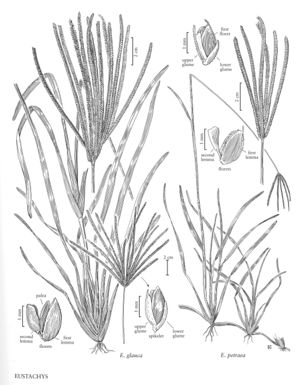Difference between revisions of "Eustachys glauca"
FNA>Volume Importer |
imported>Volume Importer |
||
| (4 intermediate revisions by 2 users not shown) | |||
| Line 4: | Line 4: | ||
|publications= | |publications= | ||
|common_names=Saltmarsh fingergrass | |common_names=Saltmarsh fingergrass | ||
| + | |special_status={{Treatment/ID/Special_status | ||
| + | |code=E | ||
| + | |label=Endemic | ||
| + | }} | ||
|basionyms= | |basionyms= | ||
|synonyms={{Treatment/ID/Synonym | |synonyms={{Treatment/ID/Synonym | ||
|name=Chloris glauca | |name=Chloris glauca | ||
| − | |authority= | + | |authority= |
| + | |rank=species | ||
}} | }} | ||
|hierarchy=Poaceae;Poaceae subfam. Chloridoideae;Poaceae tribe Cynodonteae;Eustachys;Eustachys glauca | |hierarchy=Poaceae;Poaceae subfam. Chloridoideae;Poaceae tribe Cynodonteae;Eustachys;Eustachys glauca | ||
| Line 20: | Line 25: | ||
-->{{Treatment/Body | -->{{Treatment/Body | ||
|distribution=Miss.;Fla.;Ala.;Ga.;N.C.;S.C. | |distribution=Miss.;Fla.;Ala.;Ga.;N.C.;S.C. | ||
| − | |discussion=<p>Eustachys glauca grows in the margins of low woods and in ditches and brackish marshes. It is endemic to the southeastern United States.</p> | + | |discussion=<p><i>Eustachys glauca</i> grows in the margins of low woods and in ditches and brackish marshes. It is endemic to the southeastern United States.</p> |
|tables= | |tables= | ||
|references= | |references= | ||
| Line 29: | Line 34: | ||
-->{{#Taxon: | -->{{#Taxon: | ||
name=Eustachys glauca | name=Eustachys glauca | ||
| − | |||
|authority=Chapm. | |authority=Chapm. | ||
|rank=species | |rank=species | ||
| Line 36: | Line 40: | ||
|basionyms= | |basionyms= | ||
|family=Poaceae | |family=Poaceae | ||
| − | |illustrator=Linda A. Vorobik | + | |illustrator=Linda A. Vorobik;Karen Klitz |
| + | |illustration copyright=Utah State University | ||
|distribution=Miss.;Fla.;Ala.;Ga.;N.C.;S.C. | |distribution=Miss.;Fla.;Ala.;Ga.;N.C.;S.C. | ||
|reference=None | |reference=None | ||
|publication title= | |publication title= | ||
|publication year= | |publication year= | ||
| − | |special status= | + | |special status=Endemic |
| − | |source xml=https:// | + | |source xml=https://bitbucket.org/aafc-mbb/fna-data-curation/src/200273ad09963decb8fc72550212de541d86569d/coarse_grained_fna_xml/V25/V25_813.xml |
|subfamily=Poaceae subfam. Chloridoideae | |subfamily=Poaceae subfam. Chloridoideae | ||
|tribe=Poaceae tribe Cynodonteae | |tribe=Poaceae tribe Cynodonteae | ||
Latest revision as of 18:59, 11 May 2021
Culms 60-150 cm, erect. Leaves basally disposed, glaucous; blades to 30 cm long, 4-15 mm wide, flat or folded, apices obtuse. Panicles with 8-24 branches; branches 5-15 cm. Spikelets 1.5-2(2.4) mm; florets 2. Lower glumes 1.2-1.4 mm, acute; upper glumes 1.3-1.8 mm, narrowly oblong, truncate, awned, awns 0.4-0.8 mm; calluses glabrous; lowest lemmas 1.6-2.1 mm, nar¬rowly ovate, dark brown at maturity, veins glabrous, occasionally both keels and veins with a few short, stiff hairs, apices acute, unawned, occasionally mucronate; second lemmas 1-1.3(1.6) mm, oblong, frequently keeled, acute. Caryopses about 1 mm. 2n = unknown.
Distribution
Miss., Fla., Ala., Ga., N.C., S.C.
Discussion
Eustachys glauca grows in the margins of low woods and in ditches and brackish marshes. It is endemic to the southeastern United States.
Selected References
None.
